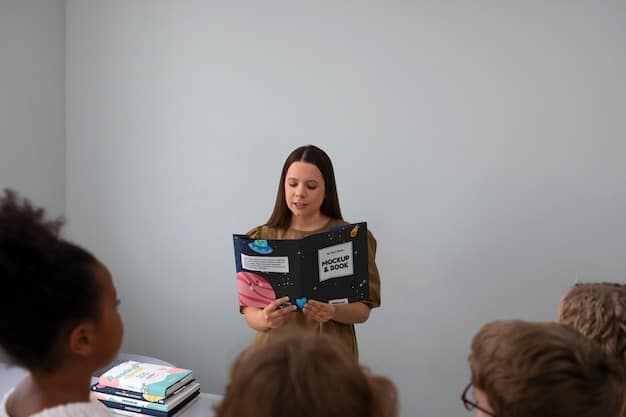The Future of Assessment: US Schools Beyond Standardized Tests

The future of assessment in US schools is shifting away from solely relying on standardized tests, incorporating diverse methods like portfolio assessments, project-based learning, and technology-enhanced evaluations to provide a more comprehensive understanding of student learning.
The landscape of education in the United States is undergoing a profound transformation, particularly in how student learning is evaluated. The traditional reliance on standardized tests is gradually giving way to a more holistic approach. This shift reflects a growing recognition of the limitations of standardized tests in capturing the full spectrum of student knowledge and skills. The conversation around the future of assessment: How US schools are moving beyond standardized tests is gaining momentum as educators and policymakers seek innovative methods to measure student progress more effectively.
Redefining Educational Measurement
The move away from standardized tests is not about abandoning assessment altogether. Instead, it’s about redefining what assessment means and how it’s conducted. A more comprehensive and nuanced understanding of student learning is sought, going beyond rote memorization and recall.
The Shortcomings of Standardized Testing
Standardized tests have long been criticized for their narrow focus. They often prioritize memorization over critical thinking, problem-solving, and creativity. Moreover, these tests can be biased, reflecting socioeconomic disparities and cultural differences rather than true academic potential.
One major issue is the pressure standardized tests put on teachers and students. The focus on test scores can lead to “teaching to the test,” narrowing the curriculum and limiting opportunities for deeper learning.

A Broader Vision for Assessment
The new vision incorporates a variety of assessment methods, providing a more complete picture of student capabilities. This includes:
- Formative Assessment: Ongoing assessment integrated into instruction to provide real-time feedback to students and teachers.
- Summative Assessment: Traditional tests and exams, but designed to measure a wider range of skills and knowledge.
- Performance-Based Assessment: Tasks that require students to apply their knowledge to real-world problems, such as projects, presentations, and exhibitions.
- Portfolio Assessment: Collections of student work that demonstrate progress over time, reflecting their learning journey.
Ultimately, redefining educational measurement means developing assessments that align with broader educational goals, fostering critical thinking, creativity, and problem-solving skills.
The Rise of Alternative Assessment Methods
As educators seek to move beyond standardized tests, alternative assessment methods are gaining popularity. These methods offer a more authentic and meaningful way to assess student learning, reflecting the skills and knowledge needed in the 21st century.
Portfolio Assessments: Showcasing Growth Over Time
Portfolio assessments involve collecting student work over a period, showcasing their progress and achievements. This method allows students to reflect on their learning journey, identifying strengths and areas for growth.
Project-Based Learning: Applying Knowledge to Real-World Problems
Project-based learning (PBL) is an instructional approach that engages students in solving real-world problems or answering complex questions. PBL allows students to apply their knowledge, develop critical thinking skills, and collaborate with peers.
These projects often require students to conduct research, analyze data, and present their findings in a variety of formats, such as reports, presentations, or multimedia projects.

Technology-Enhanced Assessments: Leveraging Digital Tools
Technology is playing an increasingly important role in assessment. Digital tools offer new opportunities for assessment, such as:
- Online simulations: Allow students to apply their knowledge to realistic scenarios.
- Adaptive testing: Adjusts the difficulty of questions based on student performance.
- Data analytics: Provide insights into student learning patterns and identify areas for intervention.
The adoption of alternative assessment methods represents a significant shift in educational philosophy, recognizing the importance of assessing not just what students know but how they can apply their knowledge to solve real-world problems.
The Role of Formative Assessment in Student Learning
Formative assessment is an integral part of effective instruction. It involves ongoing assessment practices that provide teachers and students with feedback to guide instruction and learning. Unlike summative assessments, which are typically used to evaluate student learning at the end of a unit or course, formative assessments are designed to improve student learning while it is happening.
Providing Timely Feedback
One of the key features of formative assessment is the provision of timely feedback. Teachers provide students with specific and actionable feedback on their work, helping them understand their strengths and areas for improvement.
Adjusting Instruction Based on Student Needs
Formative assessment also enables teachers to adjust their instruction based on student needs. By monitoring student progress through formative assessments, teachers can identify areas where students are struggling.
For example, if a teacher notices that many students are struggling with a particular concept, they can revisit that concept, providing additional instruction and support.
Examples of Formative Assessment Techniques
There are many different formative assessment techniques that teachers can use in the classroom, such as:
- Quick Checks: Short quizzes or polls to assess student understanding of key concepts.
- Think-Pair-Share: Students discuss a question or problem with a partner before sharing their ideas with the whole class.
- Exit Tickets: Students write down a key takeaway or question from the lesson before leaving class.
Formative assessment plays a crucial role in promoting student learning by providing timely feedback, adjusting instruction, and engaging students in the learning process.
Equity and Access in Assessment
Ensuring equity and access in assessment is paramount. Traditional standardized tests have often been criticized for perpetuating inequalities, as they can be biased and fail to account for diverse learning styles and backgrounds.
Addressing Bias in Assessment
Bias in assessment can take many forms, including cultural bias, linguistic bias, and socioeconomic bias. To address bias in assessment, educators and policymakers need to be aware of the potential sources of bias and take steps to mitigate them.
This may involve using culturally responsive assessment materials, providing accommodations for students with disabilities, and ensuring that assessments are accessible to students from diverse socioeconomic backgrounds.
Providing Accommodations for Diverse Learners
Accommodations are changes to the way an assessment is administered that do not change what the assessment measures. Common accommodations include extended time, alternative formats, and assistive technology.
Creating Accessible Assessments
Accessible assessments are designed to be usable by all students, regardless of their abilities. This may involve using clear and concise language, providing visual aids, and ensuring that assessments are compatible with assistive technology.
- Universal Design for Learning (UDL): A framework for designing instruction and assessment that is accessible to all learners.
- Culturally Responsive Teaching: An approach to teaching that recognizes and values the cultural backgrounds of all students.
Equity and access in assessment are essential for ensuring that all students have the opportunity to demonstrate what they know and can do, regardless of their backgrounds or abilities.
Challenges and Opportunities in the Transition
The shift towards alternative assessment methods presents both challenges and opportunities for US schools. While these innovative approaches hold great promise, successful implementation requires careful planning, professional development, and ongoing support.
Resistance to Change
One of the biggest challenges is resistance to change. Standardized tests have been a staple of the education system for decades, and many educators, parents, and policymakers are accustomed to them. Overcoming this resistance requires clear communication.
Professional Development and Training
Implementing alternative assessment methods requires that teachers not only understand alternative assessment principles but also how to integrate them into their teaching practices effectively.
The Role of Technology
Technology can play a crucial role in promoting equity and access in assessment. Digital tools can provide accommodations for students with disabilities.
The transition to alternative assessment methods is a complex process, but it offers a tremendous opportunity to create a more equitable and effective education system, where all students have the opportunity to thrive.
Policy Implications and Future Directions
The future of assessment is not just about changing classroom practices; it also requires policy changes at the local, state, and national levels. Policymakers need to rethink accountability systems, funding models, and teacher evaluation policies to support the transition to alternative assessment methods.
Rethinking Accountability Systems
Accountability systems that rely solely on standardized test scores can create perverse incentives, leading to “teaching to the test” and narrowing the curriculum. Policymakers must develop more holistic systems that take into account a wider range of measures.
Investing in Research and Development
More research is needed to identify the most effective alternative assessment methods and to develop tools and resources that support their implementation. Policymakers should invest in research and development.
The Future of Assessment
The development and adoption of the following principles should be considered:
- Student-Centered Assessment: Assessment should be designed to meet the needs of individual students.
- Authentic Assessment: Assessments should be designed to reflect the skills and knowledge.
The future of assessment is bright, but it requires a collective effort from educators, policymakers, parents, and students. By working together, it is possible to create a more equitable and effective education system.
| Key Point | Brief Description |
|---|---|
| 💡Alternative Assessments | Methods like portfolios and project-based learning offer richer insights. |
| 🍎 Formative Assessment | Ongoing feedback during learning helps students improve continuously. |
| 🌍 Equity in Assessment | Addressing bias ensures fair evaluation for all students. |
| ⚙️ Policy Changes | Rethinking accountability to support holistic evaluation methods. |
FAQ
▼
Alternative assessment methods are evaluation tools that differ from traditional standardized tests. Examples include portfolios, project-based learning, and performance tasks, providing a more comprehensive view of student capabilities.
▼
Standardized tests are often criticized for focusing narrowly on rote memorization rather than critical thinking and real-world application. Schools seek more holistic methods to measure student growth and skills.
▼
Formative assessment provides timely feedback to students and teachers during the learning process. This enables adjustments to instruction and allows students to understand their strengths and areas needing improvement.
▼
Technology offers new assessment opportunities through online simulations, adaptive testing, and data analytics. These tools can personalize assessment and provide deeper insights into student learning patterns and needs.
▼
Policy changes should support the transition by rethinking accountability systems and funding models. Investing in research and development of effective tools can help foster a comprehensive, equitable education system.
Conclusion
In conclusion, the shift away from standardized tests towards more holistic and diverse assessment methods signifies a positive evolution in US education. This transformation reflects a growing understanding of the need to evaluate students on a broader range of skills and knowledge, aligning assessment practices with the goals of fostering critical thinking, creativity, and real-world problem-solving abilities.





